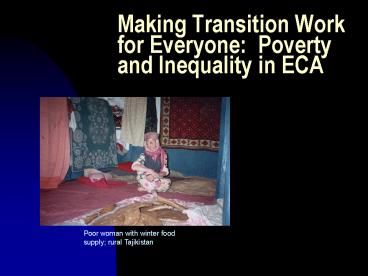Making Transition Work for Everyone: Poverty and Inequality in ECA - PowerPoint PPT Presentation
1 / 16
Title:
Making Transition Work for Everyone: Poverty and Inequality in ECA
Description:
Poor woman with stomach cancer, Armenia. Cannot afford health care. ... Result: polarized society where entrenched economic interests control policy ... – PowerPoint PPT presentation
Number of Views:19
Avg rating:3.0/5.0
Title: Making Transition Work for Everyone: Poverty and Inequality in ECA
1
Making Transition Work for Everyone Poverty and
Inequality in ECA
Poor woman with winter food supply rural
Tajikistan
2
Why a Study on Poverty and Inequality?
- Beginning of transition, we expected poverty
would increase, but be shallow and
short-livedbut - Poverty increased dramatically from 2 in 1988
to an estimated 21 in 1998! - Inequality also increased five CIS countries
have levels of inequality approaching the most
unequal countries in Latin America (greater than
Peru)
Poverty is pain it feels like a disease. It
attacks a person not only materially but also
morally. It eats away ones dignity and drives
one into total despair (a woman from Moldova)
3
The Experience of Poverty in ECA
- Fall in living standards in context of profound
changes in political, social and economic life - Voices of poor lack of income or income
insecurity is number one concern - Psychological pain as devastating as material
hardship - Poverty is not easy to discuss
Imagine traveling along in a car for seventy
years, and suddenly the road disappears and your
car crashes. You dont know where to go --Kyrgyz
Republic
4
How Many Poor?
Absolute poverty significant in IDA countries and
Russia but relative poverty is a problem
everywhere
5
Who is at Greatest Risk?
- Households with unemployed heads (especially in
Central Europe) - Multi-child households but NOT the elderly
- Rural households (especially in Central Europe)
- Some localized areas or regions (e.g. Northeast
Romania East Ukraine Imereti region Georgia ). - But the majority of the poor are working, and
live in urban areas.
Unemployed man engaged in petty trade Armenia.
6
Children are at greater risk than elderly,
especially in Central Europe
7
Capabilities of the Poor Endangered
- In some countries poor children not attending
school, poor areas not well served - Corruption a growing problem in health and in
education, hurts the poor most - Insufficient attention to nutritional
deficiencies, communicable diseases
My children cannot go to school because, without
them, I wouldnt be able to gather enough
cardboard every day (Moldova).
Poor woman with stomach cancer, Armenia. Cannot
afford health care.
8
Why Did Poverty Increase?
- Output collapse key-- but magnitude varied across
region - Collapse of output experienced by households as
decline in employment and wages - .but also as a fall in social transfers
(especially in CIS) - Increasing inequality also important factor
Decline output ? Falling Wages and Incomes
(especially marked in CIS).
9
Increases in Inequality Small in Central
Europe, Larger in FSU Countries
10
What Explains the Rise in Inequality?
- Not reforms per se ? countries further on reform
path have lower inequality - In CSB, rising education premiums and emergence
of entrepreneurs . but taxes and transfers
dampened increase - But not the case in the CIS.
11
What About the Increase in Inequality in the CIS?
- Rising education premiums explain very little of
inequality in CIS. - Causes lie elsewhere
- widespread corruption and rents
- capture of the state by vested interests that
have influenced policy to their advantage - resulting collapse of formal wages and income
opportunities - Result polarized society where entrenched
economic interests control policy agenda ? leads
to very unequal outcomes .
12
Public Action to Reduce Poverty
- Large variation in policy, performance, income
and vulnerabilities across countries - Forward-looking policy agenda has to be country
and region-specific - But common themes exist and less advanced
reformers have much to gain from experience of
those further on the transition path.
13
Key Building Blocks
- Build effective and inclusive institutions
- Provide conditions for shared growth
- Protect the poor and vulnerable
- Reduce inequality and enhance opportunities for
the poorest
- ?Tackle state capture build communities give
voice - ?Stimulate labor demand and private sector
environment build capabilities of the poor - ? Help the destitute ensure long-run equality of
opportunity for poor children balance
protection, efficiency - ?Reduce rentsmeasure to aid those at bottom,
lagging regions anti-discrimination
14
Advanced Reformer High Income (e.g. Poland,
Hungary, Czech Rep.)
15
Less Advanced Reformer Middle Income (e.g
Russia, Romania)
16
Less Advanced Reformer Lower Income (e.g.
Caucasus, Tajikistan)































